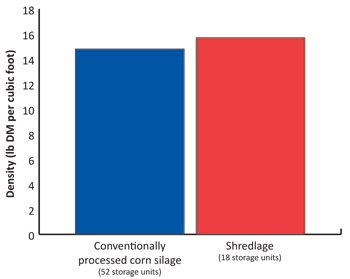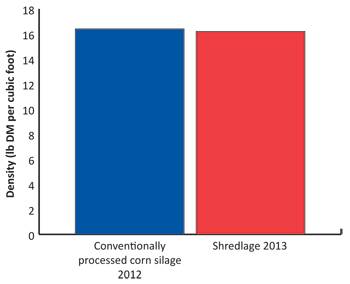
Packing better… with Shredlage? (Jon Rasmussen)
 By Jon Rasmussen, Vita Plus technology specialist
By Jon Rasmussen, Vita Plus technology specialistWe know that packing density of corn silage is affected by a multitude of factors, including moisture, cut length, weight and time of packing tractors, delivery rate to the bunker or pile, and certainly processing methods. But how does Shredlage® compare to conventionally processed silage in terms of packing density?
Early anecdotal information collected during the first University of Wisconsin trial done a couple years ago suggests that Shredlage packs at least as well – and perhaps slightly better – than conventional corn silage based on an unscientific comparison of bags. More recently and based on more data, the Shredlage folks are saying the same thing- it packs as well or better than conventional corn silage.
What does Vita Plus data say?
Each winter, Vita Plus staff consultants benchmark forage structures on a number of dairies. The team in eastern Wisconsin benchmarked 70 corn silage structures between December 2013 and January 2014. Of these structures, 52 were conventionally processed and 18 were Shredlage-processed.
In addition to those listed above, many other factors affect density, such as the chopping rate, packing layer thickness, dry matter and starch content. That makes it difficult to get a controlled side-by-side answer to the question. Thus, relying on the benchmarking data, our current opinion on this question is “it depends.”
Based on the data collected, the conventionally processed corn silage structures had an average density of 14.8 pounds of dry matter per cubic foot with a standard deviation of 2.4 pounds. Shredlage bunkers and piles had an average of 15.7 pounds of dry matter per cubic foot and a standard deviation of 2.3. Because the ranges overlapped, the results are really statistically insignificant. In fact, while the average result was slightly higher for Shredlage units, the very highest densities were found in conventionally processed silage.
Figure 1. 2013-14 Vita Plus bunker density survey

The same survey offered an interesting comparison of farms that made the processing switch from conventionally processed corn silage in 2012 to Shredlage-processed corn silage in 2013. The average densities showed 16.4 pounds of DM per cubic foot on the conventionally processed silage in 2012 versus 16.2 pounds on the Shredlage-processed corn silage in 2013. Most likely, not all the conditions were the same. Weather, crop maturity and harvest rates certainly varied from year to year.
2012 conventionally processed corn silage versus 2013 Shredlage

The question remains: Can Shredlage help improve density?
Maybe. But if packing density has been a challenge, don’t depend on switching to Shredlage to solve that problem. Following harvest management best practices from the field to the bunker or pile is still the best solution. (See related article: Hitting the numbers this corn silage season)
| Category: |
Forage Foundations Forage harvesting Forage storage and management |

